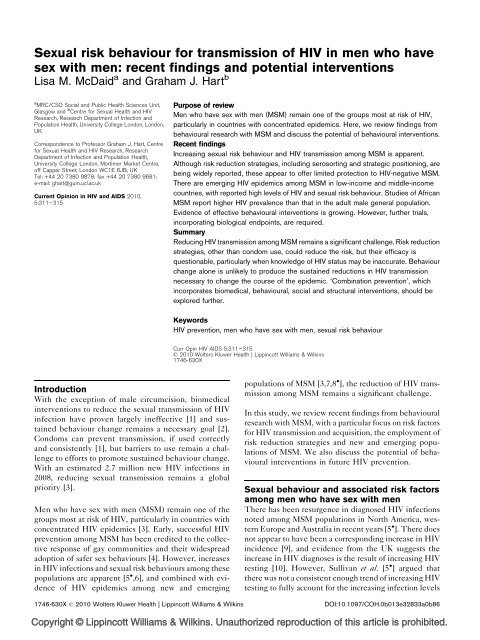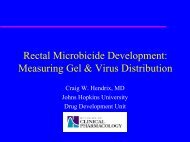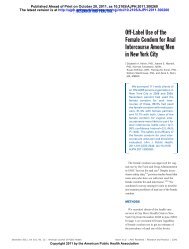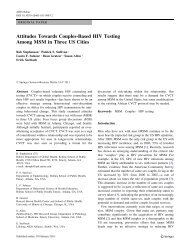Sexual risk behaviour for transmission of HIV in men who have sex ...
Sexual risk behaviour for transmission of HIV in men who have sex ...
Sexual risk behaviour for transmission of HIV in men who have sex ...
- No tags were found...
Create successful ePaper yourself
Turn your PDF publications into a flip-book with our unique Google optimized e-Paper software.
<strong>Sexual</strong> <strong>risk</strong> <strong>behaviour</strong> <strong>for</strong> <strong>transmission</strong> <strong>of</strong> <strong>HIV</strong> <strong>in</strong> <strong>men</strong> <strong>who</strong> <strong>have</strong><strong>sex</strong> with <strong>men</strong>: recent f<strong>in</strong>d<strong>in</strong>gs and potential <strong>in</strong>terventionsLisa M. McDaid a and Graham J. Hart ba MRC/CSO Social and Public Health Sciences Unit,Glasgow and b Centre <strong>for</strong> <strong>Sexual</strong> Health and <strong>HIV</strong>Research, Research Depart<strong>men</strong>t <strong>of</strong> Infection andPopulation Health, University College London, London,UKCorrespondence to Pr<strong>of</strong>essor Graham J. Hart, Centre<strong>for</strong> <strong>Sexual</strong> Health and <strong>HIV</strong> Research, ResearchDepart<strong>men</strong>t <strong>of</strong> Infection and Population Health,University College London, Mortimer Market Centre,<strong>of</strong>f Capper Street, London WC1E 6JB, UKTel: +44 20 7380 9878; fax +44 20 7380 9681;e-mail: ghart@gum.ucl.ac.ukCurrent Op<strong>in</strong>ion <strong>in</strong> <strong>HIV</strong> and AIDS 2010,5:311–315Purpose <strong>of</strong> reviewMen <strong>who</strong> <strong>have</strong> <strong>sex</strong> with <strong>men</strong> (MSM) rema<strong>in</strong> one <strong>of</strong> the groups most at <strong>risk</strong> <strong>of</strong> <strong>HIV</strong>,particularly <strong>in</strong> countries with concentrated epidemics. Here, we review f<strong>in</strong>d<strong>in</strong>gs from<strong>behaviour</strong>al research with MSM and discuss the potential <strong>of</strong> <strong>behaviour</strong>al <strong>in</strong>terventions.Recent f<strong>in</strong>d<strong>in</strong>gsIncreas<strong>in</strong>g <strong>sex</strong>ual <strong>risk</strong> <strong>behaviour</strong> and <strong>HIV</strong> <strong>transmission</strong> among MSM is apparent.Although <strong>risk</strong> reduction strategies, <strong>in</strong>clud<strong>in</strong>g serosort<strong>in</strong>g and strategic position<strong>in</strong>g, arebe<strong>in</strong>g widely reported, these appear to <strong>of</strong>fer limited protection to <strong>HIV</strong>-negative MSM.There are emerg<strong>in</strong>g <strong>HIV</strong> epidemics among MSM <strong>in</strong> low-<strong>in</strong>come and middle-<strong>in</strong>comecountries, with reported high levels <strong>of</strong> <strong>HIV</strong> and <strong>sex</strong>ual <strong>risk</strong> <strong>behaviour</strong>. Studies <strong>of</strong> AfricanMSM report higher <strong>HIV</strong> prevalence than that <strong>in</strong> the adult male general population.Evidence <strong>of</strong> effective <strong>behaviour</strong>al <strong>in</strong>terventions is grow<strong>in</strong>g. However, further trials,<strong>in</strong>corporat<strong>in</strong>g biological endpo<strong>in</strong>ts, are required.SummaryReduc<strong>in</strong>g <strong>HIV</strong> <strong>transmission</strong> among MSM rema<strong>in</strong>s a significant challenge. Risk reductionstrategies, other than condom use, could reduce the <strong>risk</strong>, but their efficacy isquestionable, particularly when knowledge <strong>of</strong> <strong>HIV</strong> status may be <strong>in</strong>accurate. Behaviourchange alone is unlikely to produce the susta<strong>in</strong>ed reductions <strong>in</strong> <strong>HIV</strong> <strong>transmission</strong>necessary to change the course <strong>of</strong> the epidemic. ‘Comb<strong>in</strong>ation prevention’, which<strong>in</strong>corporates biomedical, <strong>behaviour</strong>al, social and structural <strong>in</strong>terventions, should beexplored further.Keywords<strong>HIV</strong> prevention, <strong>men</strong> <strong>who</strong> <strong>have</strong> <strong>sex</strong> with <strong>men</strong>, <strong>sex</strong>ual <strong>risk</strong> <strong>behaviour</strong>Curr Op<strong>in</strong> <strong>HIV</strong> AIDS 5:311–315ß 2010 Wolters Kluwer Health | Lipp<strong>in</strong>cott Williams & Wilk<strong>in</strong>s1746-630XIntroductionWith the exception <strong>of</strong> male circumcision, biomedical<strong>in</strong>terventions to reduce the <strong>sex</strong>ual <strong>transmission</strong> <strong>of</strong> <strong>HIV</strong><strong>in</strong>fection <strong>have</strong> proven largely <strong>in</strong>effective [1] and susta<strong>in</strong>ed<strong>behaviour</strong> change rema<strong>in</strong>s a necessary goal [2].Condoms can prevent <strong>transmission</strong>, if used correctlyand consistently [1], but barriers to use rema<strong>in</strong> a challengeto ef<strong>for</strong>ts to promote susta<strong>in</strong>ed <strong>behaviour</strong> change.With an estimated 2.7 million new <strong>HIV</strong> <strong>in</strong>fections <strong>in</strong>2008, reduc<strong>in</strong>g <strong>sex</strong>ual <strong>transmission</strong> rema<strong>in</strong>s a globalpriority [3].Men <strong>who</strong> <strong>have</strong> <strong>sex</strong> with <strong>men</strong> (MSM) rema<strong>in</strong> one <strong>of</strong> thegroups most at <strong>risk</strong> <strong>of</strong> <strong>HIV</strong>, particularly <strong>in</strong> countries withconcentrated <strong>HIV</strong> epidemics [3]. Early, successful <strong>HIV</strong>prevention among MSM has been credited to the collectiveresponse <strong>of</strong> gay communities and their widespreadadoption <strong>of</strong> safer <strong>sex</strong> <strong>behaviour</strong>s [4]. However, <strong>in</strong>creases<strong>in</strong> <strong>HIV</strong> <strong>in</strong>fections and <strong>sex</strong>ual <strong>risk</strong> <strong>behaviour</strong>s among thesepopulations are apparent [5 ,6], and comb<strong>in</strong>ed with evidence<strong>of</strong> <strong>HIV</strong> epidemics among new and emerg<strong>in</strong>gpopulations <strong>of</strong> MSM [3,7,8 ], the reduction <strong>of</strong> <strong>HIV</strong> <strong>transmission</strong>among MSM rema<strong>in</strong>s a significant challenge.In this study, we review recent f<strong>in</strong>d<strong>in</strong>gs from <strong>behaviour</strong>alresearch with MSM, with a particular focus on <strong>risk</strong> factors<strong>for</strong> <strong>HIV</strong> <strong>transmission</strong> and acquisition, the employ<strong>men</strong>t <strong>of</strong><strong>risk</strong> reduction strategies and new and emerg<strong>in</strong>g populations<strong>of</strong> MSM. We also discuss the potential <strong>of</strong> <strong>behaviour</strong>al<strong>in</strong>terventions <strong>in</strong> future <strong>HIV</strong> prevention.<strong>Sexual</strong> <strong>behaviour</strong> and associated <strong>risk</strong> factorsamong <strong>men</strong> <strong>who</strong> <strong>have</strong> <strong>sex</strong> with <strong>men</strong>There has been resurgence <strong>in</strong> diagnosed <strong>HIV</strong> <strong>in</strong>fectionsnoted among MSM populations <strong>in</strong> North America, westernEurope and Australia <strong>in</strong> recent years [5 ]. There doesnot appear to <strong>have</strong> been a correspond<strong>in</strong>g <strong>in</strong>crease <strong>in</strong> <strong>HIV</strong><strong>in</strong>cidence [9], and evidence from the UK suggests the<strong>in</strong>crease <strong>in</strong> <strong>HIV</strong> diagnoses is the result <strong>of</strong> <strong>in</strong>creas<strong>in</strong>g <strong>HIV</strong>test<strong>in</strong>g [10]. However, Sullivan et al. [5 ] argued thatthere was not a consistent enough trend <strong>of</strong> <strong>in</strong>creas<strong>in</strong>g <strong>HIV</strong>test<strong>in</strong>g to fully account <strong>for</strong> the <strong>in</strong>creas<strong>in</strong>g <strong>in</strong>fection levels1746-630X ß 2010 Wolters Kluwer Health | Lipp<strong>in</strong>cott Williams & Wilk<strong>in</strong>s DOI:10.1097/COH.0b013e32833a0b86Copyright © Lipp<strong>in</strong>cott Williams & Wilk<strong>in</strong>s. Unauthorized reproduction <strong>of</strong> this article is prohibited.
<strong>Sexual</strong> <strong>risk</strong> <strong>behaviour</strong> <strong>for</strong> <strong>transmission</strong> <strong>of</strong> <strong>HIV</strong> McDaid and Hart 313was around 5% <strong>in</strong> the cities <strong>of</strong> four countries with datafrom respondent-driven sampl<strong>in</strong>g surveys (Croatia, Estonia,Georgia and Ukra<strong>in</strong>e) [7]. Recent research fromThailand reports <strong>HIV</strong> prevalence <strong>of</strong> 18% among MSM(21% among MSM <strong>who</strong> only had <strong>sex</strong> with <strong>men</strong> and 8%among MSM <strong>who</strong> also had <strong>sex</strong> with wo<strong>men</strong>) [27]. Studies<strong>of</strong> African MSM report higher <strong>HIV</strong> prevalence than thatamong adult <strong>men</strong> <strong>in</strong> the general population, rang<strong>in</strong>g from8% <strong>in</strong> a study <strong>in</strong> Sudan to 34% <strong>in</strong> Cape Town, SouthAfrica, though aga<strong>in</strong> results varied by the sampl<strong>in</strong>gmethod used [8 ]. Baral et al. [28 ] found <strong>in</strong>creas<strong>in</strong>g<strong>HIV</strong> prevalence with age <strong>in</strong> a study <strong>of</strong> MSM <strong>in</strong> Malawi,Namibia and Botswana, from 8% among MSM aged 18–23 years to 36% among MSM aged at least 30 years.Although <strong>HIV</strong> <strong>in</strong> the Caribbean is predom<strong>in</strong>antly attributedto hetero<strong>sex</strong>ual <strong>transmission</strong> [3], Halper<strong>in</strong> et al. [29]argue that, <strong>in</strong> the Dom<strong>in</strong>ican Republic, data suggest‘hidden’ <strong>transmission</strong> between MSM could be a significantele<strong>men</strong>t <strong>of</strong> the epidemic there, mak<strong>in</strong>g it more ak<strong>in</strong>to neighbour<strong>in</strong>g Lat<strong>in</strong> American countries [3,29].Us<strong>in</strong>g data from the 2008 United Nations General AssemblySpecial Session on <strong>HIV</strong>/AIDS (UNGASS) reports,Adam et al. [30] estimated 54% <strong>of</strong> MSM <strong>in</strong> LMIC usedcondoms at their last episode <strong>of</strong> anal <strong>in</strong>tercourse with aman. The mean weighted estimates were 38% <strong>in</strong> south andsouth-east Asia, 57% <strong>in</strong> sub-Saharan Africa, 58% <strong>in</strong> easternEurope and central Asia, 74% <strong>in</strong> the Caribbean and 73% <strong>in</strong>Lat<strong>in</strong> America [30]. Data on other <strong>sex</strong>ual <strong>risk</strong> <strong>behaviour</strong>sare limited. The mean number <strong>of</strong> male partners was 3.2,and 15% reported at least five partners, <strong>in</strong> the past 6 months<strong>in</strong> a study <strong>of</strong> MSM <strong>in</strong> Malawi, Namibia and Botswana; 54%reported both male and female <strong>sex</strong>ual partners <strong>in</strong> thistimeframe [28 ]. In Thailand, <strong>behaviour</strong>ally bi<strong>sex</strong>ualMSM reported more <strong>sex</strong>ual partners than other MSM(67 and 27%, respectively reported 6þ <strong>sex</strong>ual partners<strong>in</strong> the past 3 months) [27]. However, the <strong>for</strong>mer weremore likely to always use condoms with male partners, andwere less likely to be the receptive partner, than the latter[27]. Li et al. conclude that these factors could limit thepotential <strong>for</strong> bridg<strong>in</strong>g <strong>of</strong> <strong>in</strong>fection between MSM andhetero<strong>sex</strong>ual populations.Potential <strong>in</strong>terventions to reduce <strong>sex</strong>ual <strong>risk</strong><strong>behaviour</strong>The potential <strong>of</strong> <strong>risk</strong> reduction strategies among MSMsuch as serosort<strong>in</strong>g and strategic position<strong>in</strong>g to reduce<strong>sex</strong>ual <strong>risk</strong> <strong>behaviour</strong> and <strong>HIV</strong> <strong>transmission</strong> deservesfurther attention. One <strong>in</strong>tervention evaluation, whichreported reductions <strong>in</strong> unprotected <strong>sex</strong> with partners <strong>of</strong>unknown or discordant <strong>HIV</strong> status among <strong>HIV</strong>-positiveMSM, found this was partly due to susta<strong>in</strong>ed serosort<strong>in</strong>g<strong>in</strong> the <strong>in</strong>tervention group [31]. However, these strategiesshould be promoted with caution, particularly among<strong>HIV</strong>-negative MSM, <strong>in</strong> areas with low levels <strong>of</strong> <strong>HIV</strong>test<strong>in</strong>g (or suspected high levels <strong>of</strong> undiagnosed <strong>HIV</strong>)and when status disclosure may be problematic, giventhat efficacy is dependent on accurate knowledge <strong>of</strong>one’s own and one’s partners’ <strong>HIV</strong> status. Potentiallygreater <strong>HIV</strong> <strong>transmission</strong> <strong>in</strong> regular partnerships alsodeserves further attention, with accurate knowledge <strong>of</strong>(own and partners’) <strong>HIV</strong> status, the <strong>transmission</strong>dynamics <strong>of</strong> different <strong>sex</strong> acts and <strong>risk</strong> reduction strategiesadvocated [13 ]. Associations between drug useand <strong>HIV</strong> seroconversion signify the need <strong>for</strong> <strong>in</strong>terventionstargeted at drug us<strong>in</strong>g <strong>behaviour</strong> [14 ], and onesmall randomized controlled trial <strong>of</strong> motivational <strong>in</strong>terview<strong>in</strong>ghas reported a reduction <strong>in</strong> club drug useamong participants with low levels <strong>of</strong> drug dependency(but no effect on <strong>sex</strong>ual <strong>risk</strong> <strong>behaviour</strong>) [32]. Prestageet al. [17 ] note the need to further understand theconnection between <strong>sex</strong>ual <strong>behaviour</strong> and drug usewith<strong>in</strong> particular gay community subcultures.Understand<strong>in</strong>g the <strong>risk</strong>s <strong>for</strong> <strong>HIV</strong> <strong>transmission</strong> amongMSM <strong>in</strong> LMIC and the role <strong>of</strong> MSM <strong>in</strong> the <strong>HIV</strong> epidemics<strong>of</strong> these countries requires improved collection <strong>of</strong> reliabledata (only 58 <strong>of</strong> the 147 LMIC UN Member Statesreported on condom use among MSM to the 2008UNGASS; only 44 provided eligible data that were consistentwith the UNGASS guidel<strong>in</strong>es on the use <strong>of</strong> validquestions and survey method, and <strong>in</strong>cluded an adequatesample size) [8 ,30]. Although stigma, discrim<strong>in</strong>ation andcrim<strong>in</strong>alization rema<strong>in</strong> significant barriers to <strong>HIV</strong> preventionamong MSM <strong>in</strong> LMIC [7,8 ,29], the develop<strong>men</strong>t andimple<strong>men</strong>tation <strong>of</strong> appropriate <strong>in</strong>terventions should be apriority [8 ]. Almost half <strong>of</strong> MSM (45%) <strong>in</strong> a study <strong>in</strong>Malawi, Namibia and Botswana reported f<strong>in</strong>d<strong>in</strong>g malepartners on the Internet [28 ], and this could be a means<strong>of</strong> <strong>in</strong>tervention worth explor<strong>in</strong>g further. One recent onl<strong>in</strong>evideo <strong>in</strong>tervention reported positive results on <strong>HIV</strong>-<strong>risk</strong><strong>behaviour</strong>s, but the pretest/posttest design did not employa comparison control group, so must be <strong>in</strong>terpreted withcaution [33]. Elsewhere, only one <strong>of</strong> three Internet <strong>in</strong>terventions<strong>in</strong> a meta-analysis <strong>of</strong> computer-based <strong>in</strong>terventionshad a significant effect on condom use [34].Evidence <strong>of</strong> the potential effectiveness <strong>of</strong> <strong>behaviour</strong>al<strong>HIV</strong> prevention <strong>in</strong>terventions is grow<strong>in</strong>g, with a number<strong>of</strong> systematic reviews and meta-analyses publishedrecently [34–37]. A 2008 Cochrane review demonstratedthe effectiveness <strong>of</strong> <strong>in</strong>dividual, group and communitylevel<strong>in</strong>terventions <strong>in</strong> reduc<strong>in</strong>g high-<strong>risk</strong> <strong>sex</strong>ual <strong>behaviour</strong>among MSM and found greater effectiveness <strong>for</strong> <strong>in</strong>terventionsthat <strong>in</strong>cluded the promotion <strong>of</strong> personal skills (e.g.hav<strong>in</strong>g condoms available and avoid<strong>in</strong>g excess alcohol ordrug use) and the self-regulation <strong>of</strong> <strong>behaviour</strong> change [35].However, too few studies <strong>in</strong>cluded biological endpo<strong>in</strong>ts tomeasure <strong>HIV</strong> or STI <strong>transmission</strong> [35]. The authorsconcluded more evaluations <strong>of</strong> <strong>in</strong>terventions were needed<strong>in</strong> particular <strong>for</strong> African–American and Hispanic MSM,Copyright © Lipp<strong>in</strong>cott Williams & Wilk<strong>in</strong>s. Unauthorized reproduction <strong>of</strong> this article is prohibited.
314 <strong>Sexual</strong> <strong>transmission</strong> <strong>of</strong> <strong>HIV</strong>and <strong>for</strong> MSM <strong>in</strong> LMIC [35]. However, one recent USevaluation <strong>of</strong> an <strong>HIV</strong> prevention <strong>in</strong>tervention <strong>for</strong> blackMSM reported positive reductions <strong>in</strong> UAI with casualpartners [38 ], and Johnson et al. [36] reported <strong>in</strong>creased<strong>in</strong>tervention effectiveness on condom use <strong>in</strong> the studiesthat <strong>in</strong>cluded a greater proportion <strong>of</strong> MSM <strong>in</strong> their samples<strong>in</strong> their meta-analysis <strong>of</strong> <strong>behaviour</strong>al <strong>in</strong>terventions <strong>for</strong>African–Americans. Further trials, which <strong>in</strong>clude biologicalendpo<strong>in</strong>ts, are required. Behavioural <strong>in</strong>terventionsshould also target those most at <strong>risk</strong> <strong>of</strong> <strong>HIV</strong> <strong>transmission</strong>and <strong>in</strong> the sett<strong>in</strong>gs <strong>in</strong> which <strong>risk</strong> <strong>behaviour</strong> occurs.ConclusionIncreas<strong>in</strong>g <strong>sex</strong>ual <strong>risk</strong> <strong>behaviour</strong> and <strong>HIV</strong> <strong>transmission</strong>among MSM is apparent, although <strong>risk</strong> reduction strategiessuch as serosort<strong>in</strong>g and strategic position<strong>in</strong>g arebe<strong>in</strong>g reported more <strong>of</strong>ten. However, their efficacy isquestionable, particularly when knowledge <strong>of</strong> <strong>HIV</strong> statusmay be <strong>in</strong>accurate. The <strong>risk</strong> <strong>for</strong> <strong>HIV</strong> <strong>transmission</strong> amongMSM <strong>in</strong> LMIC, and the role <strong>of</strong> MSM <strong>in</strong> the <strong>HIV</strong>epidemics <strong>of</strong> these countries, is <strong>of</strong> special concern,particularly when <strong>HIV</strong> prevalence among AfricanMSM is reportedly higher than among the adult malegeneral population.These f<strong>in</strong>d<strong>in</strong>gs should <strong>in</strong><strong>for</strong>m future <strong>HIV</strong> preventionef<strong>for</strong>ts and evidence <strong>of</strong> effective <strong>behaviour</strong>al <strong>in</strong>terventionsis grow<strong>in</strong>g. Nonetheless, <strong>behaviour</strong> change alone isunlikely to result <strong>in</strong> the susta<strong>in</strong>ed reductions <strong>in</strong> <strong>HIV</strong><strong>transmission</strong> necessary to change the course <strong>of</strong> the<strong>HIV</strong> epidemic, and it has been argued that ‘comb<strong>in</strong>ationprevention’, which <strong>in</strong>corporates biomedical and <strong>behaviour</strong>al,as well as social and structural, <strong>in</strong>terventionsshould be the way <strong>for</strong>ward [2]. In terms <strong>of</strong> address<strong>in</strong>g<strong>transmission</strong> <strong>of</strong> <strong>HIV</strong>, this may be particularly appropriate<strong>for</strong> <strong>HIV</strong>-positive MSM [39]; to date, few exclusively<strong>behaviour</strong>al <strong>in</strong>terventions with <strong>HIV</strong>-positive MSM <strong>have</strong>been demonstrated to be effective [40]. In relation to theacquisition <strong>of</strong> <strong>HIV</strong> <strong>in</strong> MSM, one study has estimated thatall that is required to <strong>of</strong>fset the number <strong>of</strong> <strong>HIV</strong> <strong>in</strong>fectionspotentially prevented by use <strong>of</strong> preexposure chemoprophylaxisis a small (4%) <strong>in</strong>crease <strong>in</strong> the annual number <strong>of</strong>new <strong>sex</strong>ual partners [41].Biomedical <strong>in</strong>terventions necessarily <strong>in</strong>clude <strong>behaviour</strong>alcomponents (<strong>in</strong><strong>for</strong>mation, education, community mobilizationand adherence to regi<strong>men</strong>s and/or recom<strong>men</strong>ded<strong>risk</strong> reduction), and this is particularly important if we areto counter possible dis<strong>in</strong>hibition and <strong>risk</strong> compensation[42]. There rema<strong>in</strong>s an urgent need <strong>in</strong> an era <strong>of</strong> highlyeffective and successful antiretroviral treat<strong>men</strong>t to identifysuccessful <strong>HIV</strong> prevention <strong>in</strong>terventions, to keep <strong>HIV</strong>negativeMSM negative, prevent<strong>in</strong>g acquisition, and tosupport and strengthen <strong>HIV</strong>-positive <strong>men</strong>’s resolve not topass on <strong>HIV</strong> <strong>in</strong>fection, and <strong>in</strong> so do<strong>in</strong>g halt <strong>transmission</strong>.Acknowledge<strong>men</strong>tsThe UK Medical Research Council funds Dr L.M.McD. as part <strong>of</strong> the<strong>Sexual</strong> and Reproductive Health Programme (WBS U.1300.00.005) atthe Social and Public Health Sciences Unit.References and recom<strong>men</strong>ded read<strong>in</strong>gPapers <strong>of</strong> particular <strong>in</strong>terest, published with<strong>in</strong> the annual period <strong>of</strong> review, <strong>have</strong>been highlighted as: <strong>of</strong> special <strong>in</strong>terest <strong>of</strong> outstand<strong>in</strong>g <strong>in</strong>terestAdditional references related to this topic can also be found <strong>in</strong> the CurrentWorld Literature section <strong>in</strong> this issue (p. 352).1 Padian NS, Buvé A, Balkus J, et al. Biomedical <strong>in</strong>terventions to prevent <strong>HIV</strong><strong>in</strong>fection: evidence, challenges, and way <strong>for</strong>ward. Lancet 2008; 372:585–599.2 Coates TJ, Richter L, Caceres C. Behavioural strategies to reduce <strong>HIV</strong><strong>transmission</strong>: how to make them work better. Lancet 2008; 372:669–684.3 UNAIDS. AIDS epidemic update: December 2009. Geneva: UNAIDS; 2009.4 Merson MH, O’Malley J, Serwadda D, Apisuk C. The history and challenge <strong>of</strong><strong>HIV</strong> prevention. Lancet 2008; 372:475–488.5Sullivan PS, Hamouda O, Delpech V, et al. Reemergence <strong>of</strong> the <strong>HIV</strong> epidemicamong <strong>men</strong> <strong>who</strong> <strong>have</strong> <strong>sex</strong> with <strong>men</strong> <strong>in</strong> North America, western Europe, andAustralia. Ann Epidemiol 2009; 19:423–431.This study presents trends <strong>in</strong> <strong>HIV</strong> and syphilis diagnoses and relatively consistentpatterns <strong>of</strong> change <strong>in</strong> MSM <strong>in</strong> eight countries (Australia, Canada, France,Germany, The Netherlands, Spa<strong>in</strong>, the UK and the USA).6 El<strong>for</strong>d J. Chang<strong>in</strong>g patterns <strong>of</strong> <strong>sex</strong>ual <strong>behaviour</strong> <strong>in</strong> the era <strong>of</strong> highly activeantiretroviral therapy. Curr Op<strong>in</strong> Infect Dis 2006; 19:26–32.7 Bozicevic I, Vonc<strong>in</strong>a L, Zigrovic L, et al. <strong>HIV</strong> epidemics among <strong>men</strong> <strong>who</strong> <strong>have</strong><strong>sex</strong> with <strong>men</strong> <strong>in</strong> central and eastern Europe. Sex Transm Infect 2009;85:336–342.8 Smith AD, Tapsoba P, Peshu N, et al. Men <strong>who</strong> <strong>have</strong> <strong>sex</strong> with <strong>men</strong> and <strong>HIV</strong>/ AIDS <strong>in</strong> sub-Saharan Africa. Lancet 2009; 374:416–422.This study highlights the grow<strong>in</strong>g evidence <strong>for</strong> the existence <strong>of</strong> MSM populations <strong>in</strong>Africa and high rates <strong>of</strong> <strong>HIV</strong> <strong>in</strong>fection among these.9 Stall R, Duran L, Wisniewski SR, et al. Runn<strong>in</strong>g <strong>in</strong> place: implications <strong>of</strong> <strong>HIV</strong><strong>in</strong>cidence estimates among urban <strong>men</strong> <strong>who</strong> <strong>have</strong> <strong>sex</strong> with <strong>men</strong> <strong>in</strong> the UnitedStates and other <strong>in</strong>dustrialized countries. AIDS Behav 2009; 13:615–629.10 Dougan S, El<strong>for</strong>d J, Chadborn TR, et al. Does the recent <strong>in</strong>crease <strong>in</strong> <strong>HIV</strong>diagnoses among <strong>men</strong> <strong>who</strong> <strong>have</strong> <strong>sex</strong> with <strong>men</strong> <strong>in</strong> the UK reflect a <strong>risk</strong> <strong>in</strong> <strong>HIV</strong><strong>in</strong>cidence or <strong>in</strong>creased uptake <strong>of</strong> <strong>HIV</strong> test<strong>in</strong>g? Sex Transm Infect 2007;83:120–126.11Crepaz N, Marks G, Liau A, et al. Prevalence <strong>of</strong> unprotected anal <strong>in</strong>tercourseamong <strong>HIV</strong>-diagnosed MSM <strong>in</strong> the United States: a meta-analysis. AIDS2009; 23:1617–1629.This systematic review <strong>of</strong> 30 studies provides a comprehensive meta-analysis onthe prevalence <strong>of</strong> UAI among 18 121 <strong>HIV</strong>-diagnosed MSM <strong>in</strong> the USA. Althoughmost practised ‘safer <strong>sex</strong>’, 26% had UAI with a partner <strong>of</strong> unknown or discordantserostatus.12J<strong>in</strong> F, Craw<strong>for</strong>d J, Prestage GP, et al. Unprotected anal <strong>in</strong>tercourse, <strong>risk</strong>reduction <strong>behaviour</strong>s, and subsequent <strong>HIV</strong> <strong>in</strong>fection <strong>in</strong> a cohort <strong>of</strong> homo<strong>sex</strong>ual<strong>men</strong>. AIDS 2009; 23:243–252.This study used data from a prospective cohort study <strong>of</strong> <strong>HIV</strong>-negative gay <strong>men</strong> <strong>in</strong>Australia to assess the <strong>risk</strong> <strong>of</strong> <strong>HIV</strong> acquisition associated with <strong>risk</strong> reductionstrategies. Compared with no UAI, the <strong>risk</strong> <strong>of</strong> <strong>HIV</strong> <strong>in</strong>fection was not higher <strong>for</strong>negotiated safety or strategic position<strong>in</strong>g, but was three times higher <strong>for</strong> serosort<strong>in</strong>gand five times higher <strong>for</strong> withdrawal.13Sullivan PS, Salazar L, Buchb<strong>in</strong>der S, Sanchez TH. Estimat<strong>in</strong>g the proportion<strong>of</strong> <strong>HIV</strong> <strong>transmission</strong>s from ma<strong>in</strong> <strong>sex</strong> partners among <strong>men</strong> <strong>who</strong> <strong>have</strong> <strong>sex</strong> with<strong>men</strong> <strong>in</strong> five US cities. AIDS 2009; 23:1153–1162.This study estimated <strong>HIV</strong> <strong>transmission</strong>s by partner (ma<strong>in</strong> or casual) and <strong>sex</strong>(receptive anal <strong>in</strong>tercourse, <strong>in</strong>sertive anal <strong>in</strong>tercourse or oral <strong>sex</strong>) types us<strong>in</strong>g datafrom MSM <strong>in</strong> five US cities and found 68% to be from ma<strong>in</strong> rather than casualpartners because <strong>of</strong> a greater frequency <strong>of</strong> <strong>sex</strong> acts and receptive anal <strong>in</strong>tercourse,and lower levels <strong>of</strong> condom use. This has important implications <strong>for</strong> <strong>HIV</strong> preventionand <strong>in</strong>tervention plann<strong>in</strong>g.14Ostrow DG, Plankey MW, Cox C, et al. Specific <strong>sex</strong> drug comb<strong>in</strong>ationscontribute to the majority <strong>of</strong> recent <strong>HIV</strong> seroconversions among MSM <strong>in</strong> theMACS. J Acquir Immune Defic Syndr 2009; 51:349–355.This study demonstrates the <strong>in</strong>creased <strong>risk</strong> <strong>of</strong> <strong>HIV</strong> seroconversion among users <strong>of</strong>poppers, stimulants and erectile dysfunction drugs.Copyright © Lipp<strong>in</strong>cott Williams & Wilk<strong>in</strong>s. Unauthorized reproduction <strong>of</strong> this article is prohibited.
<strong>Sexual</strong> <strong>risk</strong> <strong>behaviour</strong> <strong>for</strong> <strong>transmission</strong> <strong>of</strong> <strong>HIV</strong> McDaid and Hart 31515 Berg RC. Bareback<strong>in</strong>g: a review <strong>of</strong> the literature. Arch Sex Behav 2009;38:754–764.16 Carballo-Diéguez A, Ventuneac A, Bauermeister J, et al. Is ’bareback’ a usefulconstruct <strong>in</strong> primary <strong>HIV</strong>-prevention? Def<strong>in</strong>itions, identity and research. CultHealth Sex 2009; 11:51–65.17Prestage G, J<strong>in</strong> F, Kippax S, et al. Use <strong>of</strong> illicit drugs and erectile dysfunctionmedications and subsequent <strong>HIV</strong> <strong>in</strong>fection among gay <strong>men</strong> <strong>in</strong> Sydney,Australia. J Sex Med 2009; 6:2311–2320.This study demonstrates the <strong>in</strong>creased <strong>risk</strong> <strong>of</strong> <strong>HIV</strong> seroconversion among users <strong>of</strong>erectile dysfunction drugs.18 Mimiaga MJ, Noonan E, Donnell D, et al. Childhood <strong>sex</strong>ual abuse ishighly associated with <strong>HIV</strong> <strong>risk</strong>-tak<strong>in</strong>g behavior and <strong>in</strong>fection among MSM<strong>in</strong> the EXPLORE study. J Acquir Immune Defic Syndr 2009; 51:340–348.19 Jerome RC, Halkitis PN, Siconolfi DE. Club drug use, <strong>sex</strong>ual behavior, and <strong>HIV</strong>seroconversion: a qualitative study <strong>of</strong> motivations. Subst Use Misuse 2009;44:431–447.20Agu<strong>in</strong>aldo JP, Myers T, Ryder K, et al. Accounts <strong>of</strong> <strong>HIV</strong> seroconversion amongsubstance-us<strong>in</strong>g gay and bi<strong>sex</strong>ual <strong>men</strong>. Qual Health Res 2009; 19:1395–1406.This study conducted qualitative <strong>in</strong>-depth <strong>in</strong>terviews with 30 <strong>HIV</strong>-positive gay andbi<strong>sex</strong>ual <strong>men</strong> <strong>who</strong> reported us<strong>in</strong>g drugs or alcohol at the time <strong>of</strong> their seroconversion.The <strong>men</strong>’s own understand<strong>in</strong>g <strong>of</strong> their seroconversion did not always situatesubstance use as central to it, focus<strong>in</strong>g <strong>in</strong>stead on misunderstand<strong>in</strong>gs <strong>of</strong> <strong>risk</strong><strong>behaviour</strong>, psychological problems and trust or disclosure failures.21 Golden MR, Stekler J, Hughes JP, Wood RW. <strong>HIV</strong> serosort<strong>in</strong>g <strong>in</strong> <strong>men</strong> <strong>who</strong><strong>have</strong> <strong>sex</strong> with <strong>men</strong>: is it safe? J Acquir Immune Defic Syndr 2008; 49:212–218.22 Snowden JM, Raymond HF, McFarland W. Prevalence <strong>of</strong> seroadaptive<strong>behaviour</strong>s <strong>of</strong> <strong>men</strong> <strong>who</strong> <strong>have</strong> <strong>sex</strong> with <strong>men</strong>, San Francisco, 2004. Sex TransmInfect 2009; 85:469–476.23 Velter A, Bouyssou-Michel A, Arnaud A, Semaille C. Do <strong>men</strong> <strong>who</strong> <strong>have</strong> <strong>sex</strong>with <strong>men</strong> use serosort<strong>in</strong>g with casual partners <strong>in</strong> France? Results <strong>of</strong> anationwide survey (ANRS-EN17-Presse Gay 2004). Euro Surveill 2009;14:pii, 19416 (http://www.eurosurveillance.org/ViewArticle.aspx?ArticleId=19416).24Zablotska IB, Imrie J, Prestage GP, et al. Gay <strong>men</strong>’s current practice <strong>of</strong> <strong>HIV</strong>seroconcordant unprotected anal <strong>in</strong>tercourse: serosort<strong>in</strong>g or seroguess<strong>in</strong>g?AIDS Care 2009; 21:501–510.This study reports 27% <strong>of</strong> <strong>HIV</strong>-positive MSM and 34% <strong>of</strong> <strong>HIV</strong>-negative MSM <strong>who</strong>reported serosort<strong>in</strong>g could be better described as ‘seroguess<strong>in</strong>g’ because theyassumed, rather than knew, their partners’ <strong>HIV</strong> status, an important consideration<strong>in</strong> the promotion <strong>of</strong> this <strong>risk</strong> reduction strategy.25 Campbell MS, Gottlieb GS, Hawes SE, et al. <strong>HIV</strong>-1 super<strong>in</strong>fection <strong>in</strong> theantiretroviral therapy era: are seroconcordant <strong>sex</strong>ual partners at <strong>risk</strong>? PLoSOne 2009; 4:e5690.26 Williamson LM, Dodds JP, Mercey DE, et al. <strong>Sexual</strong> <strong>risk</strong> <strong>behaviour</strong> andknowledge <strong>of</strong> <strong>HIV</strong> status among community samples <strong>of</strong> gay <strong>men</strong> <strong>in</strong> theUK. AIDS 2008; 22:1063–1070.27 Li A, Varangrat A, Wimonsate W, et al. <strong>Sexual</strong> behavior and <strong>risk</strong> factors <strong>for</strong> <strong>HIV</strong><strong>in</strong>fection among homo<strong>sex</strong>ual and bi<strong>sex</strong>ual <strong>men</strong> <strong>in</strong> Thailand. AIDS Behav 2009;13:318–327.28Baral S, Trapence G, Motimedi F, et al. <strong>HIV</strong> prevalence, <strong>risk</strong>s <strong>for</strong> <strong>HIV</strong> <strong>in</strong>fection,and human rights among <strong>men</strong> <strong>who</strong> <strong>have</strong> <strong>sex</strong> with <strong>men</strong> (MSM) <strong>in</strong> Malawi,Namibia, and Botswana. PLoS One 2009; 4:e4997.This cross-sectional study <strong>of</strong> MSM <strong>in</strong> three African countries reports worry<strong>in</strong>glyhigh <strong>HIV</strong> prevalence <strong>of</strong> 17% overall and an <strong>in</strong>crease with age, from 8% among the18–23-year age group to 36% among the at least 30-year age group.29 Halper<strong>in</strong> DT, de Moya A, Pérez-Then E, et al. Understand<strong>in</strong>g the <strong>HIV</strong> epidemic<strong>in</strong> the Dom<strong>in</strong>ican Republic: a prevention success story <strong>in</strong> the Caribbean?J Acquir Immune Defic Syndr 2009; 51:S52–S59.30 Adam PC, de Wit JB, Tosk<strong>in</strong> I, et al. Estimat<strong>in</strong>g levels <strong>of</strong> <strong>HIV</strong> test<strong>in</strong>g, <strong>HIV</strong>prevention coverage, <strong>HIV</strong> knowledge, and condom use among <strong>men</strong> <strong>who</strong> <strong>have</strong><strong>sex</strong> with <strong>men</strong> (MSM) <strong>in</strong> low-<strong>in</strong>come and middle-<strong>in</strong>come countries. J AcquirImmune Defic Syndr 2009; 52:S143–S151.31 Mor<strong>in</strong> SF, Shade SB, Steward WT, et al. A behavioral <strong>in</strong>tervention reduces<strong>HIV</strong> <strong>transmission</strong> <strong>risk</strong> by promot<strong>in</strong>g susta<strong>in</strong>ed serosort<strong>in</strong>g practices among<strong>HIV</strong>-<strong>in</strong>fected <strong>men</strong> <strong>who</strong> <strong>have</strong> <strong>sex</strong> with <strong>men</strong>. J Acquir Immune Defic Syndr 2008;49:544–551.32 Morgenstern J, Bux DA Jr, Parsons J, et al. Randomized trial to reduce clubdrug use and <strong>HIV</strong> <strong>risk</strong> behaviors among <strong>men</strong> <strong>who</strong> <strong>have</strong> <strong>sex</strong> with <strong>men</strong>. J ConsultCl<strong>in</strong> Psychol 2009; 77:645–656.33 Chiasson MA, Shaw FS, Humberstone M, et al. Increased <strong>HIV</strong> disclosurethree months after an onl<strong>in</strong>e video <strong>in</strong>tervention <strong>for</strong> <strong>men</strong> <strong>who</strong> <strong>have</strong> <strong>sex</strong> with <strong>men</strong>(MSM). AIDS Care 2009; 21:1081–1089.34 Noar SM, Black HG, Pierce LB. Efficacy <strong>of</strong> computer technology-based <strong>HIV</strong>prevention <strong>in</strong>terventions: a meta-analysis. AIDS 2009; 23:107–115.35 Johnson WD, Diaz RM, Flanders WD, et al. Behavioural <strong>in</strong>terventions toreduce <strong>risk</strong> <strong>for</strong> <strong>sex</strong>ual <strong>transmission</strong> <strong>of</strong> <strong>HIV</strong> among <strong>men</strong> <strong>who</strong> <strong>have</strong> <strong>sex</strong> with <strong>men</strong>.Cochrane Database Syst Rev 2008:CD001230. doi: 001210.001002/14651858.CD14001230.pub14651852.36 Johnson BT, Scott-Sheldon LA, Smoak ND, et al. Behavioral <strong>in</strong>terventions<strong>for</strong> African Americans to reduce <strong>sex</strong>ual<strong>risk</strong><strong>of</strong><strong>HIV</strong>:ameta-analysis<strong>of</strong>randomized controlled trials. J Acquir Immune Defic Syndr 2009; 51:492–501.37 Noar SM, Palmgreen P, Chabot M, et al. A 10-year systematic review <strong>of</strong> <strong>HIV</strong>/AIDS mass communication campaigns: <strong>have</strong> we made progress? J HealthCommun 2009; 14:15–42.38Wilton L, Herbst JH, Coury-Doniger P, et al. Efficacy <strong>of</strong> an <strong>HIV</strong>/STI prevention<strong>in</strong>tervention <strong>for</strong> black <strong>men</strong> <strong>who</strong> <strong>have</strong> <strong>sex</strong> with <strong>men</strong>: f<strong>in</strong>d<strong>in</strong>gs from the ManyMen, Many Voices (3MV) project. AIDS Behav 2009; 13:532–544.This study presents f<strong>in</strong>d<strong>in</strong>gs from a small randomized controlled trial <strong>of</strong> one <strong>of</strong> thefirst <strong>HIV</strong> prevention <strong>in</strong>terventions specifically designed <strong>for</strong> black MSM.39 Hart GJ, El<strong>for</strong>d J. <strong>Sexual</strong> <strong>risk</strong> <strong>behaviour</strong> <strong>of</strong> <strong>men</strong> <strong>who</strong> <strong>have</strong> <strong>sex</strong> with <strong>men</strong>: emerg<strong>in</strong>gpatterns and new challenges. Curr Op<strong>in</strong> Infect Dis 2010; 23:39–44.40 Crepaz N, Lyles CM, Wolitski RJ, et al. Do prevention <strong>in</strong>terventions reduce <strong>HIV</strong><strong>risk</strong> <strong>behaviour</strong>s among people liv<strong>in</strong>g with <strong>HIV</strong>? A meta-analytic review <strong>of</strong>controlled trials. AIDS 2006; 20:143–157.41 Desai K, Sansom SL, Ackers ML, et al. Model<strong>in</strong>g the impact <strong>of</strong> <strong>HIV</strong> chemoprophylaxisstrategies among <strong>men</strong> <strong>who</strong> <strong>have</strong> <strong>sex</strong> with <strong>men</strong> <strong>in</strong> the UnitedStates: <strong>HIV</strong> <strong>in</strong>fections prevented and cost-effectiveness. AIDS 2008;22:1829–1839.42 Hogben M, Liddon N. Dis<strong>in</strong>hibition and <strong>risk</strong> compensation: scope, def<strong>in</strong>itions,and perspective. Sex Transm Dis 2008; 35:1009–1010.Copyright © Lipp<strong>in</strong>cott Williams & Wilk<strong>in</strong>s. Unauthorized reproduction <strong>of</strong> this article is prohibited.










